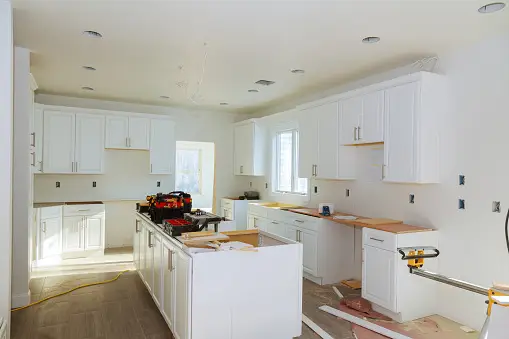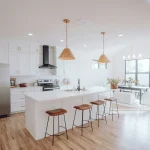Welcome to the journey of transforming a 1970s split-level kitchen. Split-level homes were once the epitome of the American Dream. The unique architectural elements present both challenges and opportunities for remodeling. This article will guide you through modernizing a 1970s split-level kitchen while preserving its historical charm, from understanding the history of split-level homes to practical tips on updating kitchen cabinets. We have got you covered. Let’s dive in and explore the potential of your split-level kitchen remodel.
Popularity and Decline of Split-Level Homes
During the 1970s, split-level homes were seen as a modern and efficient use of space. They were offering separate living areas within the same footprint. They provided a unique blend of openness and separation. She was making them an attractive option for many families. Architectural trends shifted towards more open-concept designs and single-story living. The popularity of split-level homes began to wane.
The Unique Architecture of Split-Level Homes
The architecture of split-level homes is unique and offers both challenges and opportunities for remodeling. The staggered floor levels create distinct zones within the home, which can be advantageous for creating separate living, dining, and sleeping areas. These same features can also present challenges when creating a cohesive design aesthetic throughout the home and understanding the unique architectural elements of split-level homes. It is vital to successfully remodel and modernize them, particularly when it comes to kitchen remodels.
The 1970s Kitchen: A Look Back
The 1970s was a decade of bold style and design, which was reflected in the kitchens of the time.
Materials and Design of 1970s Kitchen Cabinets
Kitchen cabinets in the 1970s were often made from inexpensive materials such as particleboard with laminate or wood veneer finishes. The design was typically simple and functional, focusing on maximizing storage space. Bold colors, such as avocado green and harvest gold, were popular choices for cabinet finishes.
These materials and design choices can look dated by today’s standards. The particleboard construction is less durable than solid wood, and the laminate or veneer finishes can wear out over time. Additionally, the popular bold colors in the 1970s may not align with current aesthetic preferences.
The Challenges of Selling Split-Level Homes
While unique and full of character, split-level homes can sometimes be challenging to sell. This is mainly due to their unconventional layout and the dated aesthetic that often comes with homes built in the 1970s.
The layout of split-level homes with their staggered floors and compartmentalized rooms. It can deter potential buyers who prefer the open-concept layouts popular in modern home design. The aesthetic of these homes, particularly in areas like the kitchen, can feel outdated. They are making it more challenging for potential buyers to envision themselves living there.
These challenges are manageable with thoughtful remodeling and modernization. It is possible to transform a 1970s split-level home into a desirable property. A key area to focus on is the kitchen, which is often considered the heart of the home. Update the kitchen to reflect modern tastes. You can significantly increase the appeal of a split-level home.
Remodeling a Split-Level Home: Is It Possible?
Yes, it is possible to remodel a split-level home. The unique layout of these homes can provide exciting opportunities for creative remodeling projects.
Split-level homes were designed efficiently, making the most of the available space. It means that even though the layout may seem unconventional by today’s standards. We can offer a lot of flexibility when it comes to remodeling.
One of the critical areas to focus on when remodeling a split-level home is the kitchen. One of the most frequently used rooms in any home, the kitchen can significantly influence the overall feel and functionality of the space.
In a 1970s split-level home, the kitchen is often located on the main level, with easy access to the living and dining areas. Make it an ideal candidate for an open-concept remodel. It can help to modernize the space and make it feel more cohesive.
Approaching such a project with a clear plan and realistic expectations is essential. Remodeling a split-level home can be a significant undertaking requiring careful planning and potentially substantial investment. It is possible to transform a dated split-level home into a modern, comfortable, and highly desirable living space.
Modernizing a 70s Split-Level Home
Modernizing a 70s split-level home involves updating its design elements to reflect contemporary tastes while preserving the unique architectural features that give the home its character.
Enhancing the Aesthetics of a Split-Level Home
The first step in modernizing a split-level home is to enhance its aesthetics. It can be achieved by updating the exterior with new siding or paint. It replaces outdated fixtures and fittings and introduces modern design elements.
One of the most effective ways to modernize a split-level home is to open up the floor plan. It can create a more spacious and invite environment. Make the home feel more extensive and more cohesive. Removing walls between the kitchen and living areas can create an open-concept design popular in modern homes.
Another critical aspect of modernizing a split-level home is updating the kitchen. The kitchen is often the heart of the home. And modernizing it can have a significant impact on the overall feel of the house. It can involve updating the cabinets, countertops, appliances, and flooring to reflect modern tastes.
Revamping 1970s Kitchen Cabinets
The kitchen cabinets are a central focal point in any kitchen, and this is particularly true in a split-level home where the kitchen is often centrally located. Therefore, updating the kitchen cabinets can have a important impact on the overall aesthetic of the home.
Upgrading Old Kitchen Cabinets Without Replacement
One of the most cost effective ways to update your kitchen cabinets is to upgrade them without replacement. It can be achieve through a variety of methods:
- Painting or Refacing: One of the simplest ways to update your kitchen cabinet is to paint them. It can instantly freshen up the look of your kitchen and allow you to choose a color that suits your modern aesthetic. If your cabinets are wood, consider refacing them. It involves replacing the old cabinet doors and drawer fronts with new ones while keep the existing cabinet boxes.
- Changing Hardware: Another easy update is to change the hardware on your cabinets, like the handles and knobs. This small change can make a big difference to the look of your kitchen.
- Adding Organizational Features: Modern kitchens are all about convenience and efficiency. Adding organizational features such as pull-out shelves, lazy Susans, and built-in spice racks can make your kitchen more functional and appealing.
The End of Split-Level Homes
Split-level homes, once a staple of American suburban architecture, have declined in popularity over the years. They remain a significant part of American architectural history.
Split-level homes first emerged in the mid-20th century during rapid suburban expansion. They offered a unique solution to the challenges of suburban living, providing efficient use of space and separation of living areas. They made them an attractive option for many families and quickly became a popular choice for suburban homes.
Architectural trends shifted towards more open-concept designs and single-story living, and the popularity of split-level homes began to wane. By the late 20th century, they were being built less frequently, and today they are relatively rare.
Despite this, split-level homes continue to hold a certain nostalgic charm. Their unique design and efficient use of space make them an exciting option for homeowners looking for something different. A split-level home can be transformed into a modern, comfortable living space with thoughtful remodeling.







